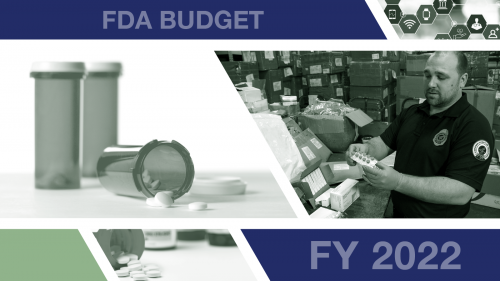FDA’s Budget: Advancing the Goal of Ending the Opioid Crisis

By: Janet Woodcock, M.D., Acting Commissioner of Food and Drugs
As we confronted the COVID-19 pandemic over the past year, many of the existing public health challenges we face as a nation did not suddenly disappear. The opioid crisis in particular has remained an urgent public health priority for the U.S. Food and Drug Administration, particularly as the crisis has continued to expand, devastating families and communities across the nation.
The investments outlined in the FDA’s FY 2022 budget request would address current public health needs and allow the agency to design programs intended to tackle complex challenges facing the country, such as those needed in addressing the opioid crisis, by supporting development of new therapies and smarter enforcement.
The FY 2022 budget requests an increase of $38.0 million above the FY 2021 enacted level to support activities in the FDA’s Center for Drug Evaluation and Research (CDER), the Office of Regulatory Affairs (ORA), and the Center for Devices and Radiological Health (CDRH) in their work on the opioid crisis. This funding supports the U.S. Department of Health and Human Services’ department-wide initiative to advance the goal of ending the opioid crisis.
Addressing Priority Areas and Developing New Treatments
As part of broad cross-government efforts, the FDA is committed to examining all facets of opioid abuse, misuse, addiction, overdose and death in the U.S. The agency is taking steps to address four priority areas to address the crisis: (1) decreasing exposure and preventing new addiction; (2) supporting the treatment of those with opioid use disorder (OUD); (3) fostering the development of novel non-opioid pain treatment therapies; and (4) improving enforcement and assessing benefit-risk.
Within CDER, an increase of $26.0 million above the FY 2021 enacted level will support development of opioid overdose reversal treatments and treatments for OUD. CDER will, among other things: assess feasibility to integrate the opioid Risk Evaluation and Mitigation Strategies (REMS) education into Information Technology (IT) health systems/electronic health records and explore use of health IT systems to support goals of this REMS, such as prescriber education; and, continue to support opioid research efforts.
Meanwhile, CDER continues to work on evaluating potential opioid disposal and packaging requirements based on our authorities under the SUPPORT (Substance Use-Disorder Prevention that Promotes Opioid Recovery and Treatment [SUPPORT] for Patients and Communities) Act. Other recent CDER actions to address the opioid crisis include the issuance of the final guidelines for opioid use disorder treatment endpoints; opioid label updates related to naloxone prescribing; and approval of naloxone products.
Expansion of Staffing and Tools for Labs at International Mail Facilities
As we work to help develop new treatments, strengthen safety measures, and ultimately lower the number of opioid and stimulant overdose deaths, we continue our rigorous efforts to target the illicit market for diverted opioids and illegal drugs, and secure the supply chain for legitimate medications, including opioids.
This includes combatting illegal online sales of opioids and other controlled substances, as well as increasing our enforcement and interdiction work targeting illegal, unapproved, counterfeit and potentially dangerous products that are shipped illegally through International Mail Facilities (IMFs).
Within ORA, an increase of $10.0 million above the FY 2021 enacted level will allow the FDA to establish satellite laboratories at selected IMFs to include permanent staffing by scientists along with expanding ORA’s use of analytical tools for screening entries, and expand the current IMF initiative to interdict shipments of illicit opioids, unapproved foreign drugs, counterfeit pharmaceuticals and health fraud related shipments.
In FY 2020, the FDA reviewed over 50,000 products at the IMFs and identified 215 illicit opioids, with 98.6% of those being either destroyed, refused, or referred to either the FDA’s Office of Criminal Investigations or the U.S. Customs and Border Protection (CBP). Additionally, a Satellite Laboratory support system and a Chicago IMF Satellite Laboratory were established in partnership with CBP to address the opioid crisis, which helped increase the total number of packages examined and subsequently screened for the presence of opioids. This builds upon the work the FDA has done to increase our presence at the IMFs since 2018.
Additionally, compounding and outsourcing facility inspections have added an investigational assessment for compounding of opioids and opioid products. These expanded investigations involve analyzing supply chains along with production activities at the compounding facilities. Additional resources are needed as the outsourcer inventory has grown along with the products produced, and supply chains have become more complex.
Advancing Digital Health Medical Devices for Opioid Use Disorder
The availability of digital health medical devices like mobile apps can play a unique and important role in helping to treat OUD. Such devices can help individuals receiving medication-assisted OUD treatment stay engaged in their treatment programs, and provide clinicians with new ways to support patients during treatment and beyond.
Within CDRH, $2.0 million of new funding will allow the FDA to advance the development, evaluation, and marketing authorization of digital health medical devices – such as digital diagnostics, therapeutics, and risk assessment tools – that can benefit patients and healthcare providers during treatment of OUD and through longer-term support. For example, digital health technologies can keep patients motivated and connected during treatment programs, and enable patient monitoring in a timely and convenient manner. Funding will allow the FDA to establish a framework to facilitate premarket interactions with developers and to incentivize the development of innovative digital health devices, such as through a design-a-thon or other activities. It can also support an infrastructure for the FDA’s evaluation of digital products that increases analytic capabilities, leverages real world data, and incorporates patient perspectives in the premarket assessment and postmarket surveillance of digital devices intended for use in OUD.
Our goal is to provide Americans experiencing OUD with more therapeutic options and greater support throughout their recovery. The FDA will continue our efforts to address the national opioid crisis in FY 2022 and beyond.
We will update the public on other key FDA budget priorities in future FDA Voices and look forward to continuing to work with Congress to ensure the FDA has the resources it needs to carry out our vital public health mission to protect and promote the public health.

